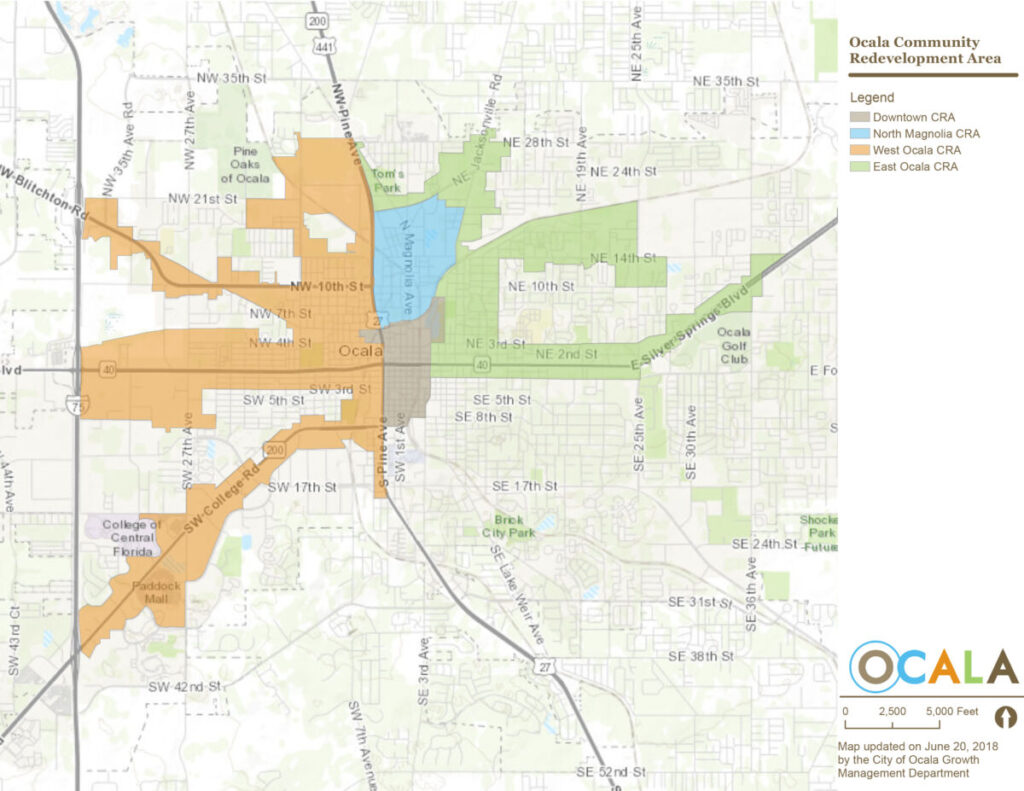What’s a CRA?

Ocala CRA Map [Supplied]
The Ocala City Council approved a new grant program for residential façade and property improvements in the North Magnolia Community Area (CRA) on Jan. 18.
The intention of the North Magnolia CRA Imagine Residential Façade and Property Improvement grant program is to encourage owner-occupants of single-family homes in the Marion Heights neighborhood to make exterior improvements to their homes and property.
Of the 41 homes in the neighborhood, 14 are owner-occupied. This grant program is a component of a comprehensive revitalization, which includes construction of new housing, sewer and water line extensions, a neighborhood park and commercial development along North Magnolia Avenue.
The framework of the proposed residential grant program is similar to the North Magnolia CRA Commercial Property program. It’s eligible work elements are: (1) exterior painting/paint removal for the entire building; including exterior cleaning and/or repair/replacement of façade details/materials—doors, walls, trim and exterior lighting; (2) repair or replacement of windows, awnings; (3) new landscaping area (trees and shrubs) visible from the street/sidewalk, removal of hazardous trees; (4) fencing; and (5) reroofing.
Grants cannot be used to correct outstanding code violations in an active code enforcement case. Only work begun after approval by the Ocala CRA will be eligible for a grant. Work in progress or performed before approval will not be eligible.
The maximum amount for a grant is $10,000 and the required match is 25% of project cost for each applicant (75% for the city). Once the program for owner-occupied homes is underway, a grant for rental properties may be considered.
Eligible applicants must be a property owner. Eligible buildings are single-family or owner-occupied. Ineligible properties include tax delinquent property; property in litigation; property in condemnation or receivership; property or tenants with outstanding financial obligations to City, requiring City Council approval.
Put simply, the source of the grants is a CRA, which are primarily used with businesses (The Mellow Mushroom is a good example). But…
What is a CRA?
Under Florida Law (Chapter 163, Part III), local governments are able to designate areas as Community Redevelopment Areas (CRAs) when certain conditions exist that meet the statutory definition of “slum and blight,” according to the City of Ocala’s website.
Examples of conditions that can support the creation of a CRA include the presence of substandard or inadequate structures, a shortage of affordable housing, poor infrastructure, insufficient roadways and lack of parking.
To document that the required conditions exist, the local government must survey the proposed redevelopment area and prepare a “find of necessity.” If a necessity is found, a CRA can be created.
CRAs are the publicly financed rebuilding of an older urban area distressed by social, physical, environmental or economic conditions that discourage private investment. The goal of the Ocala CRA is to transform underutilized properties into productive assets to improve the community.
The Ocala City Council members serve as the CRA Board; but legally, it is a separate entity than the council itself. The CRA Board meets prior to City Council meetings, as needed, on the first and third Tuesday of the month at 4 p.m. at City Hall.
Growth Management Department staff monitor and administer projects and programs for the Ocala CRA.
The Ocala CRA now contains four subareas: Downtown (established in 1988), North Magnolia (1999), West Ocala (2015) and East Ocala (2016).
The original purpose of the CRA was to create a redevelopment framework in which the Downtown district would evolve into a more dynamic mixed-use area with a variety of activities including dining, entertainment, retail, cultural, office, financial, residential and governmental uses.
Each of the four subareas of the Ocala CRA has their own separate trust fund, called Tax Increment Financing or TIF. The money collected within the boundaries of each subarea is deposited into the associated trust fund. Expenditure of trust fund money must be done within the subarea from where it was generated.
Ty Chighizola, director of Growth Management for the City of Ocala, explained to the “Gazette” how a TIF works.
“Let’s say downtown real estate is valued at $1 million,” said Chighizola. “Anything beyond that $1 million value over the next 32 years is more money for downtown. So, if it’s $10 million, that $9 million in growth is part of the CRA, and that $1 million is part of that TIF.”
“All that money from that $1 million can go anywhere in the city or county, but that $9 million…that growth…that stays in the CRA,” he added. “So, the county doesn’t get that portion of it. And the city can’t use it for anywhere else other than that CRA.”
“You have your regular taxes based on what it was frozen at, and then the growth,” he concluded. “So that money gets invested into that area.”
If you live or have a business within the North Magnolia CRA, visit https://www.ocalafl.org/government/city-departments-a-h/growth-management/cra-special-districts/community-redevelopment-agency/downtown-cra to learn more about the grant program.





